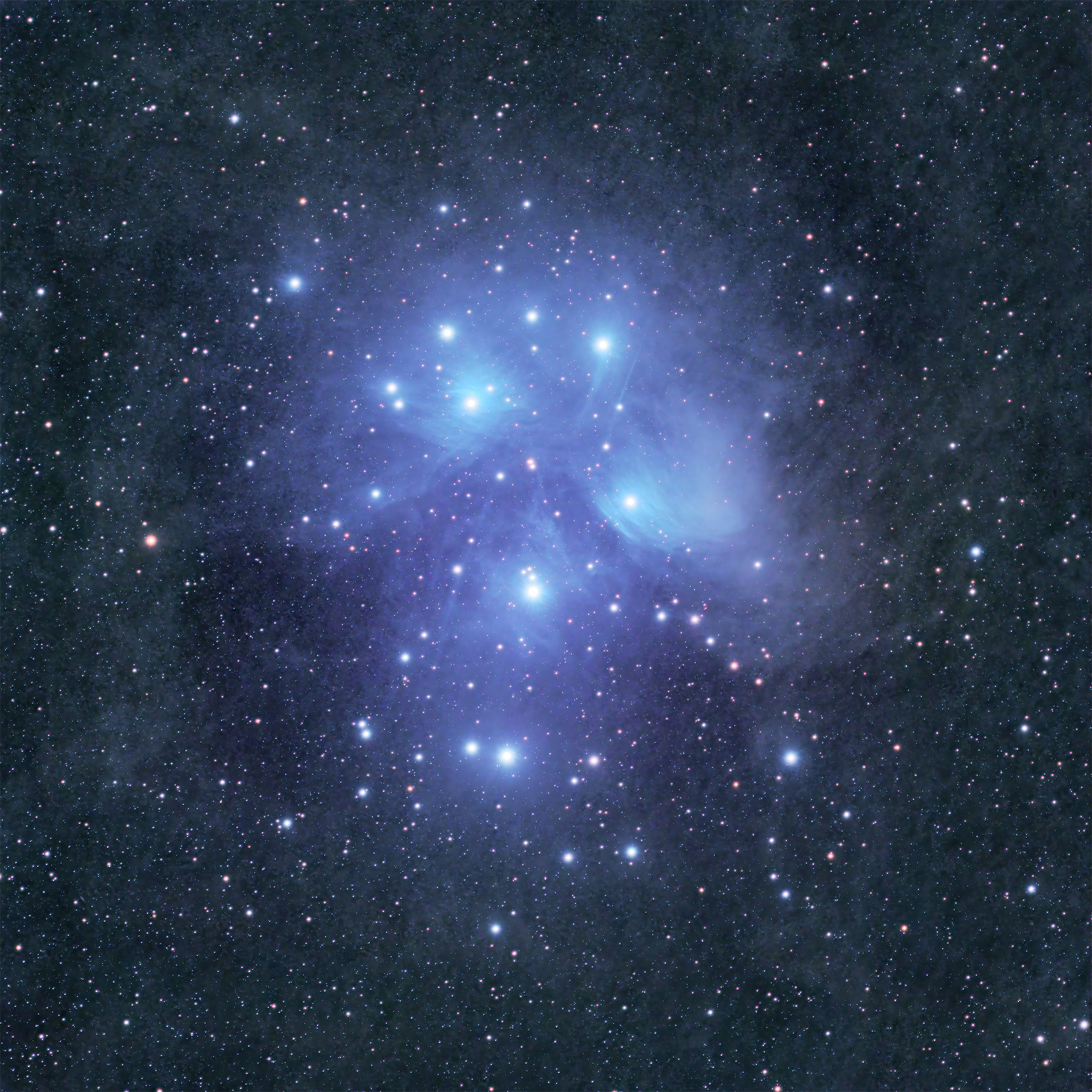The Pleiades is a target that I will take every year. The glowing young blue patch of stars that’s only 100 million years old (that’s young in astronomy!) is a staple of the night sky for anybody who begins astronomy. In this article, I explore the challenges of shooting M45 in light pollution, where I live right outside New York City.
Going All Out on M45 with 16 Hours of Data
This year, I wanted to go all out. I took 16 hours of data with a heavier emphasis on the RGB channels, vs. doing minimal RGB and then all luminance. Last year, it was only about 6 hours. The goal was to bring out more of the dust and nebulosity that surrounds the Pleiades, including the Merope Nebula and Maia Nebula, which surround the stars uh…Merope and Maia. I think I somewhat succeeded or succeeded as good as someone can living in a heavily light-polluted area (Bortle 9 bordering 8).
Shooting the Pleiades in Light Pollution
Bringing out the faint reflection nebula and dust in light-polluted skies is not a simple task. I had to plan well. I waited until the Pleiades were highest in the sky (1-2 hours before the meridian) so I got it at its highest point where there is less light pollution in the sky. Another consideration is moonless nights. The Moon’s brightness makes capturing the reflection nebula difficult. One can capture the Pleiades stars with a 1-second (or less) exposure, but the faint reflection nebula surrounding them requires longer exposures. I took 3-minute exposures and captured roughly 9 hours of RGB and 7 hours of luminance.
The image of M45 below was one of my first takes on this. The goal was to bring out the surrounding “brownish” area that is dust. My photo definitely had underlying brown areas of dust, but even at 16 hours, this proved too difficult to bring out in my light polluted skies. Although the brownish dust is there, it looks noisy, which I dislike. I’d rather have less noise and less signal. Noise is not good.

Shooting broadband targets, even those as bright as M45, are always issues in light-polluted skies. Somebody in darker skies could likely shoot about 4-6 hours of data and get the same results as I did in 16 hours. I don’t mind shooting so much data. This is where I live, and it’s convenient to do it in my backyard with my completely automated setup. I wouldn’t want to travel to a dark sky site and read a book all night in my car. I’d rather be spending time with my family at my house while my rig runs in the background. The downside of not going to a dark sky site is that I’ll never get an image like this that brings out the faint dust and reflection nebula (in only 9 hours) in my light polluted skies.
Processing my M45 Data in Pixinsight
Processing 16 hours of light-polluted data is a challenge. First off, your stars are as bright as they can be. Second, you need to do some serious dynamic background extraction. Third-finding a balance between bringing out the faint reflection nebula and blowing out the stars is a challenge. I thought using Star Xterminator to isolate the stars and then bring up the brightness of the reflection nebula in my starless image would work, but when merged back together, it looked unnatural. Last, you have mostly a dark background—the night sky, and you want to keep it dark. Bringing up the faint nebula increases the lightness of the dark background and reduces the overall contrast.
Processing Pleiades may not only be a challenge with light-polluted data. It’s likely a challenge anywhere because of its vast dynamic range, but light pollution makes it all that more challenging. I believe in keeping my processing simple. I also believe that capturing everything in camera should be a priority when creating. It’s so much harder to fix something out of focus or not exposed correctly in post-production. Below are the steps I took to create this photo in Pixinsight.
Linear Processing of M45
Processing of all 4 channels: Red, Green, Blue Luminance.
Applied to All Channels
The following steps are applied to each channel before creating the RGB image.
- Dynamic Crop
- Dynamic Background Extraction
- BlueXTerminator (paid plugin, but super worth it)
- Histogram Transformation
Creation of RGB Image
- Channel Combination, Create RGB image
- Image Solver Script (to prepare for Spectrophotometric Color Calibration)
- Spectrophotometric Color Calibration
- Histogram Transformation (multiple transformations, no longer linear)
- Histogram Transformation of Luminance image
Non-Linear Processing of M45
- LRGB Combination (apply the luminance channel to RGB)
- Noise Xterminator (paid plugin, but super worth it)
- SCNR (neutral green, 100%)
- Star Xterminator (paid plugin, but super worth it)
- Curves Transformations X 2 to starless image
- PixelMath to recombine stars and starless images
- More Curves Transformations (contrast, luminance, saturation, etc.)
- Noise Xterminator again
- Final Curves Translation, make it a touch darker
View this on Astrobin for more information about integration time.
